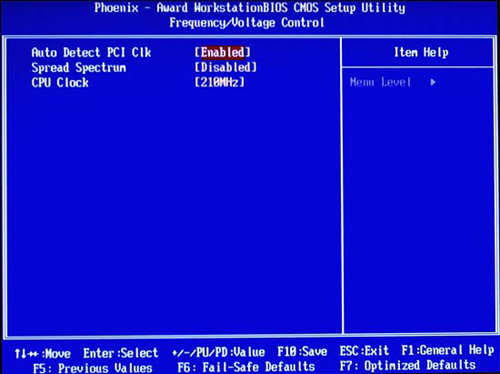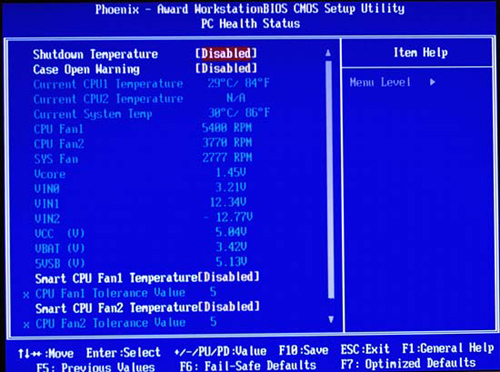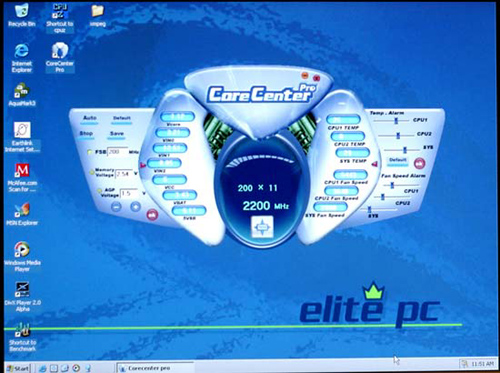Elite PC Titan FX: Setting New Standards in Gaming
by Wesley Fink on November 30, 2003 10:57 PM EST- Posted in
- Systems
Elite PC Titan FX: BIOS and Overclocking

The Titan FX uses the familiar Award BIOS on the MSI K8T Master 2 motherboard. The available options should be very familiar to the Gamer and Computer Enthusiast who are the target audience for the Elite PC Titan FX, so we will not repeat the obvious.

While there is a Frequency and Voltage control section in the BIOS, the only adjustment that can be made is to the CPU FSB, with a range of 200 to 233. There are no adjustments available at all for voltage.

This also extends to the memory timings options. While you can force memory speed, there are no adjustments available for memory timings. Fortunately, the MSI does read and set SPD timings properly, which is why we see the excellent 2-3-2-8 timings with the Mushkin High Performance ECC Registered memory.

A very complete selection of system monitoring functions is available in the BIOS for the MSI K8T. This includes the option to control fan speeds automatically. We strongly recommend you use these fan control options to set the system for automatic fan speeds controlled by system temperature.

The Titan FX also comes with MSI's Core Center Pro windows-based utility for system monitoring and overclocking control. Since there are so few real options for tweaking and overclocking on this Workstation board, Core Center is mainly useful as a monitoring utility that works in Windows. None of the overclocking controls appear to work, but it is possible to set monitoring options.
FSB Overclocking Results
We are not surprised that only very limited overclocking controls are available on a board that is aimed at the Workstation market. With so few controls, we really did not expect much in overclocking, but we were able to reach a raw speed of 211 (844FSB), or about a 6% overclock, with stability. Any setting above 211 caused memory failure. We have tested Mushkin and OCZ's registered memory to about 220 (DDR440) with slower timings on other motherboards.| Front Side Bus Overclocking Testbed Default Voltage |
|
| Processor: | Athlon64 FX1 2.2GHz |
| CPU Voltage: | 1.5V (default) |
| Cooling: | AVC/MSI Heatsink/Fan |
| Power Supply: | Sparkle 460W |
| Maximum OC: | 2320MHz (+6%) 211FSB |
We have been able to reach overclocks of about 230 (DDR460) by lowering the memory setting to 333 on nF3 boards as well. We suspect that if we had the ability to increase memory voltage or actually tweak memory timings, we might get better overclocks on this board.
Elite PC Titan FX: Stress Testing
We performed stress tests on the Elite PC Titan FX in these areas and configurations:1. Chipset and motherboard stress testing, conducted by running the FSB at 210MHz.
2. Memory stress testing, conducted by running RAM at 400MHz with 2 DIMM slots filled and at 400MHz with all 4 DIMM slots filled at the lowest memory timings possible.
Front Side Bus Stress Test Results:
A full range of stress tests and benchmarks were run to ensure the Titan FX system was absolutely stable at the overclocked FSB speed of 211. This included Prime95 torture tests, and the addition of other tasks like data compression, various DX8 and DX9 games, and apps like Word and Excel. Finally, we ran our benchmark suite, which includes ZD Winstone suite, Unreal Tournament 2003, SPECviewperf 7.0, and Gun Metal Benchmark 2. At default voltage, 211MHz was the highest overclock that we were able to achieve with the Titan FX while running these tests. Since failures at higher overclocks were always related to memory, we suspect that we could achieve a higher overclock if memory timings were adjustable on the MSI K8T Master-2 motherboard.Memory Stress Test Results:
The memory stress test simply tests the ability of the Titan FX system to operate at its officially supported memory frequency (400MHz DDR) at the lowest supported memory timings that the shipped Mushkin High Performance ECC Registered Modules will support:| Stable DDR400 Timings — 2 DIMMs (2/4 Dual-Channel DIMMs populated) |
|
| Clock Speed: | 200MHz |
| Timing Mode: | N/A |
| CAS Latency: | 2.0 |
| Bank Interleave: | N/A |
| RAS to CAS Delay: | 3T |
| RAS Precharge: | 8T |
| Precharge Delay: | 2T |
| Command Rate: | N/A |
We had no problem running the 2 DS 512MB DIMMs in Dual-Channel mode with complete stability. While the motherboard sets SPD timings only, the actual memory timings that were running were 2-3-2-8 as confirmed by CPU-Z, Version 1.20a.
Filling all available memory banks is more strenuous on the memory subsystem than testing 2 DIMMs, so we tried filling all 4 memory slots — 2 Dual-Channel banks — with Mushkin High Performance ECC memory. While the system would reach the initial boot screen, it could not complete a system boot. We thought perhaps that the SPD timings might be a bit aggressive for 4 DIMMs on the VIA K8T800 board, so we tried 4 x 512Mb Legacy Electronics Registered ECC DIMMs, which we have run in an nVidia nForce3 Reference Board with no problems. The Legacy registered memory has 2.5-3-3-6 timings, but the 4 DIMMs of Legacy memory also would not boot. We also could not get even 2 sticks of Legacy CAS 2.5 to boot on the MSI K8T Master. We then tried OCZ EC registered 3200 and Kingston ECC Registered 3200. Both these memories booted fine when we installed 2 DIMMs. The OCZ has 2-3-2-8 timings like the Mushkin, while the Kingston is based on Samsung chips and has 3-3-3-8 timings.
Finally, we tried 4 Kingston ECC Registered DIMMs, which we had pulled from another system. While 2 booted fine, we could not get 4 DIMMs to go past the initial boot screen. In the end, no combination of 4 DS 512MB ECC Registered DIMMs would work. It appears the MSI K8T Master-2 is very sensitive to the memory it is fed. Our advice is to plan to use 2 DIMMs, or to order the Titan FX with 4 DIMMs. Elite PC does offer this option and this should deliver the working 4 DIMMs if that is what you want. Do not plan to just grab 4 ECC Registered DIMMs for this board as there is no assurance that they will work properly.
Frankly, we have seen difficulty going beyond 2 DIMMs on VIA K8T800 motherboards for both Athlon64 and Athlon64FX Opteron. It appears that the chipset is very picky about the memory used beyond 2 DIMMs.










50 Comments
View All Comments
sprockkets - Tuesday, December 2, 2003 - link
Adding, but how much of the system actually follows industry standards. Like why would I want a D/Hell with a stupid bios that is worse than features included even on uATX boards?sprockkets - Tuesday, December 2, 2003 - link
The power supply is FSP, and unlike the stupid dell is not proprietary. FSP are known for making good PS. Like the ones with the 120mm fans inside them.Of course the p4 systems can be faster with the RAID setup but neverless impressive. You should compare not only the specs and scores.
Wesley Fink - Tuesday, December 2, 2003 - link
Doop - While AMD has stated from the beginning that the FX would not be multi-processor capable, MANY reviews have speculated that the shipping FX chips did not, in fact, have the 2nd and 3rd HT links disabled. If links were not disabled, then the chips WOULD work in a dual-processor board. Manufacturers tell us many things, but we still prefer to find out for ourselves, because things often turn out not to be exactly what we have been told by manufacturers.Now that we have tested this for ourselves, the article has been corrected. We have also added the recommendations from Elite PC on multiple CPU selection to the review, and I have just received a written response from AMD. We have done our best to answer the question with hands-on testing in a timely manner, and post the information as soon as it is available.
I also read many other sites, and I don't recall an actual attempt to run 2 FX51 chips being reported. The question has never been AMD's intention with FX, but there have been many questions as to whether the other two HT links were actually being disabled on FX chips. We can now say that on FX chips we have tested, Dual-Processor operation with FX chips did not work, and the Opteron 2 and higher series should be used for dual processors.
Doop - Tuesday, December 2, 2003 - link
tfranzese, not many people think the Athlon FX is dual capable. AMD has clearly stated that they are not. This article was clearly not up Anandtech's usually extremely high level.Now this is purely wild speculation on may part but it could be possible that you get higher yeilds of opteron cores if you accept some with not all the functioning hypertransport links.
Just like Radeons with 4 instead of 8 pipelines.
You could enable the hypertransport links but there is possibility that you've got a chip where the links needed for dual operation will never work.
tfranzese - Tuesday, December 2, 2003 - link
I don't think it's been clear, because I and others were under the assumption that they were not disabled in an effort to get them out asap. Might have just been engineering samples though, because these assumptions came from an article.Shinei - Tuesday, December 2, 2003 - link
Uh, tfraneze, I'm pretty sure it's been clear since the start that the FX-51 has had and always will have two disabled HT links... Turning them on MIGHT be possible, but that depends on how much time and money you're willing to waste (since a mistake can cost you $800).Shinei - Tuesday, December 2, 2003 - link
Uh, tfraneze, I'm pretty sure it's been clear since the start that the FX-51 has had and always will have two disabled HT links... Turning them on MIGHT be possible, but that depends on how much time and money you're willing to waste (since a mistake can cost you $800).tfranzese - Tuesday, December 2, 2003 - link
Locutus, the board is a design that uses only one memory controller to cut down on traces. There's a recent article, I think from GamePC that compares it with an Extended ATX dual board with use of both memory controllers.Wesley Fink - Tuesday, December 2, 2003 - link
#31 - The board is located on the MSI site under 'server workstation' at http://www.msi.com.tw/program/products/server/svr/... As stated in the review the board is the VIA K8T800 chipset.Locutus4657 - Tuesday, December 2, 2003 - link
I couldn't find this motherboard on the MSI web site. But to me it looks like this is a dual system using a via chipset? If so I didn't think this was possible... Or at the very least sane. Could some one confirm this?